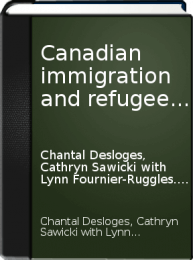As one who looks at immigration from a data and policy perspective, reading Canadian Immigration and Refugee Law: A Practitioner’s Handbook, deepened my understanding of legal perspectives and experience in supporting clients through the various immigration and refugee processes.
Practitioners Chantal Desloges and Cathryn Sawicki have compiled a comprehensive and practical handbook that I found particularly useful in deepening my understanding of the intricacies of immigration policies. The Handbook is impressive, close to 700 pages, broken into 16 chapters, with an extensive glossary, table of cases, and index. Each chapter starts with a helpful introduction explaining the relevant policies and programs. The table of contents is helpfully designed to allow readers to go directly to the topic of interest.
Complex yet readable
The book features helpful graphics: organization charts, flow charts, and summary tables. The tables are particularly helpful and cover a range of areas: the roles and responsibilities of different actors, contrasting different programs (e.g., between the Temporary Foreign Worker Program and the International Mobility Program), occupational codes, the nature and steps in the processes, and the key provisions of the relevant legislation along with the relevant articles.
While the material is complex, and the intricacies appear almost infinite, the authors have made every attempt to write in as accessible language as possible. Yet this more accessible language does not “dumb down” the complexity of the content, but rather makes the material easier to follow and, I expect, to explain to clients. This was further aided by selected media stories that highlight the practical impacts of the issues and decisions discussed (e.g., an article on what immigration officers look for with respect to applications for spousal sponsorship).
“I kept on asking myself who might be the potential audience for such a comprehensive treatment beyond the obvious ones of current and future immigration lawyers and reputable immigration consultants?”
The Handbook also includes some statistics (e.g., different waves of refugees) although in my view, too sparingly, as some sections such as permanent residency, would benefit from a data breakdown of the various programs to provide greater context.
The Handbook focuses on practical advice for counsel in representing clients. This is particularly extensive with respect to family class immigration, immigration appeals, the refugee determination process and judicial review, likely reflecting where most immigration law practice takes place.
The recurring advice applying to all sections is that the responsibility lies with the applicant in making any application or request for consideration, the need for honesty and disclosure by the applicant (and counsel’s professional responsibility to cease representation if the applicant is not being truthful) and that file prepared should be complete and well-organized to facilitate decision maker review. Implicitly, this essentially is a recommendation to use counsel in these areas of more complex immigration law.
I do have, however, a few quibbles with some of the material:
-
- The International Mobility Program discussion of trade agreements should be framed more as a trade in services agreement with immigration provisions, rather than an immigration agreement;
- The cursory treatment of the Quebec-Canada immigration accord is understandable given the Handbook’s focus but gives the impression of a greater role with respect to refugees than is warranted. The current debate over whether Quebec can reduce immigration levels for refugees and family class immigrants being the most recent illustration;
- The coverage of federal business immigration program changes is comprehensive but would benefit from some coverage of provincial programs given some of their controversies (e.g., Quebec essentially being a back door entry to British Columbia, Prince Edward Island fraud cases);
- Perhaps given my greater familiarity with citizenship, as well as the greater focus on immigration by most lawyers, the authors miss a number of points:
- The Handbook presents the Liberal government’s restoring partial pre-permanent residency time as a new measure in C-6, rather than the restoration of the previous provision eliminated under the Conservative government in C-24;
- The lack of recourse to the Federal Court in cases of fraud or misrepresentation under the Conservative government is covered but not the reversal of that change by the Liberal government;
- The numbers of “Lost Canadians” are overstated as press accounts are anecdotal and the number of citizenship proofs requested showed no major sustained changes following the various efforts to address gaps; and,
- Citizenship fees were increased to $530 in 2015, not 2014.
Thinking of audience
One nice touch, the Handbook uses she and her as much as he and him in referring to persons rather than just one gender.
As I was reading the Handbook, I kept on asking myself who might be the potential audience for such a comprehensive treatment beyond the obvious ones of current and future immigration lawyers and reputable immigration consultants? It is clearly a specialized publication, not designed for the general public, even if written in an accessible manner.
Policy practitioners generally rely on consultation with government lawyers to ensure their policy proposals are in conformity with law. However, reading the Handbook, I found that I benefited from both the general and more specific treatment of the issues, and have already returned to the Handbook to answer some media enquiries.
Certainly, policy practitioners new to immigration would benefit from reading the specific chapter relevant to their work. While it may be too much to expect (hope?) that political staffers and political commentators would read relevant sections to the issues of the day, they would clearly benefit from doing so, as some ill-informed debates regarding Canada’s international and domestic obligations regarding asylum seekers illustrate. Other potential audiences would include academics and think tank experts specialized in immigration.
Overall, the Handbook lives up to its billing as a practitioners handbook — one relevant to anyone with a specialized professional interest in immigration issues.

The preceding review originally appeared in Andrew Griffith’s blog, Multicultural Meanderings. Andrew is the former Director-General of Citizenship and Immigration Canada, Citizenship and Multiculturalism branch. He is a fellow of the Canadian Institute for Global Affairs and the Environics Institute, and a member of New Canadian Media.
Andrew Griffith is the author of Multiculturalism in Canada: Evidence and Anecdote, Policy Arrogance or Innocent Bias: Resetting Citizenship and Multiculturalism and many other works. He is a former Director-General of Citizenship and Immigration Canada, Citizenship and Multiculturalism branch. He regularly comments on citizenship, multiculturalism and related issues, in this blog and the media.






